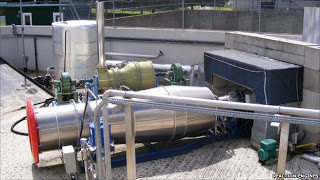Sabre’s precooler technology will be put through its paces on a test rig this summer
The Sabre propulsion system is essential to the success of the project.The engine would burn hydrogen and oxygen to provide thrust – but in the lower atmosphere this oxygen would be taken directly from the air.
At high speeds, Sabre would have to manage 1,000-degree gasses entering its intake. This hot air would need to be cooled prior to being compressed and burnt with hydrogen. Reaction Engines’ answer is a novel precooler heat-exchanger.
Schematic of the Sabre engine which will power the skylon spaceplane and the position of the precooler
This would incorporate arrays of extremely fine piping to extract the heat and plunge the intake gases to minus 130C in just 1/100th of a second.
Ordinarily, the moisture in the air would be expected to freeze out rapidly, covering the network of fine piping in a blanket of frost and dislocating its operation.
But REL says it has developed an anti-frost solution that will allow the heat exchanger to run and run. Esa’s technical staff have witnessed this “secret technology” on the lab bench and can confirm it works. The agency’s experts say they also fully expect a scaled up version of the precooler technology to function properly this summer when it is tested in conjunction with a standard jet engine.
Assuming, this summer’s test programme does indeed achieve its goals, Reaction Engines says private investors will release £220m ($350m) of funds to take Skylon into the next phase of its development.
This would include the production of a ground demonstrator that would show off Sabre’s full engine cycle – its air-breathing and rocket modes and the transition between the two.
One possible avenue for funding would be military funding from the US or Europe.
The Reaction Engines Limited A2 (called the A2) is a design study for a hypersonic airliner. It would be able to fly at more than Mach 5. It calls for the use of liquid hydrogen as a fuel. The vehicle is intended to have about 20,000 kilometres (12,000 mi) range and good subsonic and supersonic fuel efficiency, thus avoiding the problems inherent in earlier supersonic aircraft.
The USA is willing to spend $500 billion to 1 trillion for 2443 F35 stealth multi-role fighters over the next 20 years. $20 billion of development cost for more than Mach 5 capability would be a bargain.
The SR-71 Blackbird could cruise at Mach 3.2
If you liked this article, please give it a quick review on ycombinator or StumbleUpon. Thanks

Brian Wang is a Futurist Thought Leader and a popular Science blogger with 1 million readers per month. His blog Nextbigfuture.com is ranked #1 Science News Blog. It covers many disruptive technology and trends including Space, Robotics, Artificial Intelligence, Medicine, Anti-aging Biotechnology, and Nanotechnology.
Known for identifying cutting edge technologies, he is currently a Co-Founder of a startup and fundraiser for high potential early-stage companies. He is the Head of Research for Allocations for deep technology investments and an Angel Investor at Space Angels.
A frequent speaker at corporations, he has been a TEDx speaker, a Singularity University speaker and guest at numerous interviews for radio and podcasts. He is open to public speaking and advising engagements.




